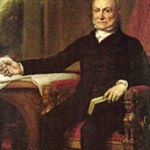After several decades gone by, the American political system continues to pattern the original political parties of the past, not without evolving into a much stronger government, however. The history of our Constitution is very enlightening; it demonstrates our nation’s diversity, strengths, and differences. Prior to our nation establishing a new Constitution on March 4, 1789, two political parties existed, the Federalists and the Republicans, of course today we know the two parties as the Democratic and Republican Parties. Those who were apart of the Federalist Party were in support of the new Constitution, or government, and were led by John Adams, Alexander Hamilton, John Jay, and Washington (Sage). The opposing group, known as anti-federalists, was of the Democratic Republican Party, led by Thomas Jefferson, and Madison (Sage).
The political parties in 1789-1860 were in a major political divide, this began during the American Revolution; the last half of the 18th Century when the Thirteen Colonies became the United States of America, and gained their independence from the British Empire. The Federalist and Republicans harbored such resentment toward each other, because each party believed their view of the American Revolution and the Constitution was more profound than that of the other party. The early republic, until recently, has been, “the most neglected if not the most despised period of American History (Woods, pars.5). It is clear that the political parties’ debate and divide was rooted in the fact that each party had their own view of how the new world order would benefit their beliefs and uphold their own political convictions.
The new Constitution was officially adopted on September 17,1787, by the Constitutional Convention in Philadelphia, Pennsylvania, it was later ratified by the convention in each state in the name of “the People” (Library of Congress).
The Anti-Federalists, known as the Republicans, rejected the decision of the Constitution, and were adamant about convincing the people to reject it as well, because the Constitution did not yet have a Bill of Rights. The people, however, strayed from the convictions of the Anti-Federalist due to the overwhelming need for change, and did not reject the Constitution. Many states did submit their recommendations for amendments to the Constitution, so that they as a people would be able to add certain rights. The Bill of Rights was then and is presently apart of our Constitution, created by the thirteen states to acknowledge that certain rights will be upheld by the government (usconstitution.net).
Throughout the ratification of the Constitution, the Federalist and the Anti-Federalist were in opposition about this new government, which had so many uncertainties and flaws in the view of the Anti- Federalist. The Federalist was successful in achieving their desired result of having the Constitution ratified in all thirteen states, despite the arguments of those that opposed them (usconstitution.net). The Federalist formed a very loose Federalist Party after this great victory; it was not established on much of a foundation because it ended by 1824 (usconstitution.net).
The Anti-Federalist, however, gravitated towards the views of Thomas Jefferson, they became the Republican Party, which would later be known as the Democratic Republicans, the precursor of today’s Democratic Party (usconsititution.net).
Our Nation’s political system underwent some major changes from 1789 -1860; those changes continue to influence and affect us as Americans presently. From the Constitution, to Congress passing new laws, our judicial system, and state laws, those critical times of our Founding Father’s labor, sacrifice, convictions, and disagreements has an impacted our way of life, and has shaped our culture as we know it today.
Works Cited
Sage, Henry. The New Republic: The United States.” 2005. .
Wood, Gordon. “The Significance of the Early Republic.” 2002. .
Liberty of Congress Primary Documents in American History the United States Constitution .
US Constitution Online.net. Constitutional Amendments.
.



